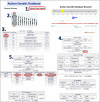Autism Genetic Database (AGD): a comprehensive database including autism susceptibility gene-CNVs integrated with known noncoding RNAs and fragile sites
- PMID: 19778453
- PMCID: PMC2761880
- DOI: 10.1186/1471-2350-10-102
Autism Genetic Database (AGD): a comprehensive database including autism susceptibility gene-CNVs integrated with known noncoding RNAs and fragile sites
Abstract
Background: Autism is a highly heritable complex neurodevelopmental disorder, therefore identifying its genetic basis has been challenging. To date, numerous susceptibility genes and chromosomal abnormalities have been reported in association with autism, but most discoveries either fail to be replicated or account for a small effect. Thus, in most cases the underlying causative genetic mechanisms are not fully understood. In the present work, the Autism Genetic Database (AGD) was developed as a literature-driven, web-based, and easy to access database designed with the aim of creating a comprehensive repository for all the currently reported genes and genomic copy number variations (CNVs) associated with autism in order to further facilitate the assessment of these autism susceptibility genetic factors.
Description: AGD is a relational database that organizes data resulting from exhaustive literature searches for reported susceptibility genes and CNVs associated with autism. Furthermore, genomic information about human fragile sites and noncoding RNAs was also downloaded and parsed from miRBase, snoRNA-LBME-db, piRNABank, and the MIT/ICBP siRNA database. A web client genome browser enables viewing of the features while a web client query tool provides access to more specific information for the features. When applicable, links to external databases including GenBank, PubMed, miRBase, snoRNA-LBME-db, piRNABank, and the MIT siRNA database are provided.
Conclusion: AGD comprises a comprehensive list of susceptibility genes and copy number variations reported to-date in association with autism, as well as all known human noncoding RNA genes and fragile sites. Such a unique and inclusive autism genetic database will facilitate the evaluation of autism susceptibility factors in relation to known human noncoding RNAs and fragile sites, impacting on human diseases. As a result, this new autism database offers a valuable tool for the research community to evaluate genetic findings for this complex multifactorial disorder in an integrated format. AGD provides a genome browser and a web based query client for conveniently selecting features of interest. Access to AGD is freely available at http://wren.bcf.ku.edu/.
Figures


References
-
- Fombonne E. Epidemiology of autistic disorder and other pervasive developmental disorders. J Clin Psychiatry. 2005;66:3–8. - PubMed
Publication types
MeSH terms
Substances
Grants and funding
LinkOut - more resources
Full Text Sources
Other Literature Sources
Research Materials
Miscellaneous

